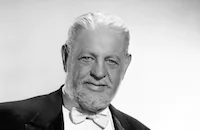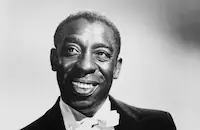The Public Menace

Brief Synopsis
Cast & Crew
Erle C. Kenton
Jean Arthur
George Murphy
Douglass Dumbrille
George Mckay
Robert Middlemass
Film Details
Technical Specs

Synopsis
Egotistical reporter Red Foster is sent to cover the arrival of an ocean liner. On the press boat, Red meets another reporter from Detroit, who informs him that Public Enemy Number One, Tonelli, is under arrest aboard the ship. Red meets the ship's manicurist, Cassie, who has lost her American citizenship due to a mistaken allegiance to Greece. Cassie tells Red that she has a story about a big kidnapping, but she will only tell it to him if he agrees to marry her, so that she can re-enter the country. While the captain is marrying the couple, Tonelli escapes the ship with the help of the mysterious Detroit reporter, who is actually one of his henchmen. The gangsters escape on the press boat, taking the other reporters hostage. Red misses the entire story, and it is headline news the next day. He is fired from his paper, and forced to take a job selling magazine subscriptions. When a man is burned alive in an automobile accident, Cassie calls the newspaper, telling them that she has a red-hot story, but she will only give it to Red. Red is immediately rehired, and Cassie tells him that the burned man was Tonelli. Red's story is only freshly printed when the very-alive Tonelli machine-guns to death his old girl friend and her new lover. Red is once again fired, and Cassie is arrested for falsely identifying Tonelli. Tonelli becomes suspicious of Cassie's motives, and arranges for her bail. Tonelli then has her taken to his apartment, where she is followed by the police. Cassie manages to get a phone message to Red, who arrives at the apartment in an ambulance. He and Cassie convince Tonelli that they can sneak him past the police cordon in the ambulance. He agrees, but once they have the gangster in the ambulance, they deliver him to the editorial room of Red's old newspaper. Tonelli's capture becomes an exclusive story for the paper, and Red is immediately rehired. The couple then decides to stop fighting, and finally go on a real honeymoon.

Director
Erle C. Kenton
Cast

Jean Arthur

George Murphy

Douglass Dumbrille

George Mckay
Robert Middlemass
Victor Kilian
Charles C. Wilson
Gene Morgan
Murray Alper

Shirley Grey

Bradley Page
Arthur Rankin

Thurston Hall
Fred Kelsey

Clarence Muse
Harry Holman
Selmer Jackson
Huey White
Vessie Farrell
Raymond Brown
Landers Stevens
Pepi Sinoff

Emmett Vogan
Dick Elliott
Edward Lesaint
Jimmy Eagles
Stanley Mack
Lloyd Whitlock
Jack Daley
Frank Rice
Stanley Blystone
Alan Sears
Jack Richardson
Dick Rush
Walter James
Roger Gray
Frank Halliday
Budd Fine
Rodney Hildebrand
Jack Cheatham
Aaron Edwards
Tom Ricketts
Lois Lindsey
Joe Cunningham
Wally Phelps
William Gould
Chris Frank
A. R. Haysel
Ky Robinson
Henry Hall
Philip Morris
Howard Chase
Claude Payton
"pop" Kenton

Wilfred Lucas
Harry Strang
Hal Price
Lee Shumway
Jack Carlyle
Edward Peil Sr.
John Ince
Harrison Greene
Harry Dunkinson
Henry Sylvester
Florence Ho
Nina Campana
Charles King
Paul Jones
John Tyrrell
James Harrison
Kernan Cripps
Allen Caven
George Cleveland
Hal Greene
Frank O'connor
Bruce Mitchell
Jack Kenny
Art Berry
Eddie Craven
Robert Kerr
Bill Dill
Earle Bunn

Howard Mitchell
Loo Loy
Mark Strong
Mitchell Ingraham
Charlie Sullivan
Jack Boston
Bert Scott
Frank Holliday
Don Roberts
Harry Hollingsworth
Buddy Messinger
Matty Roubert
Billy Engle
Geneva Mitchell
Jane Kerr
Jessie Arnold
Edwin Argus
Irma Harrison
William Humphries
Corinne Williams
Crew

Photo Collections
Videos
Movie Clip



Film Details
Technical Specs

Articles
The Public Menace (1935) - The Public Menace
The Public Menace, written by Ethel Hill and Lionel Houser, was directed by Erle C. Kenton in 1935, just three years after he made Island of Lost Souls (1932), a picture that would become a horror classic. Kenton was something of a jack of all trades: He began his career as an actor, appearing in a number of Mack Sennett comedies. In the late 'teens, Sennett gave him a chance to direct, launching a career that included mostly comedies (Kenton helmed several Abbott & Costello features in the 1940s, including Pardon My Sarong [1942] and Who Done It? [1942]) and horror pictures (among them House of Dracula [1945] and House of Frankenstein [1944], in addition to the aforementioned Lost Souls). The Public Menace is, of course, unlike any of those films, an almost-screwball comedy that at times seems more confused than comic: It's never quite clear, for example, why the manicurist, Cassie, keeps telling overt untruths in order to further her husband's newspaper career and thus keep him around, when she must know that at some point her lies are sure to come to light and reflect badly on her.
But the more confusing aspects of The Public Menace hardly matter, thanks to the presence of Jean Arthur: Her character makes sense in an emotional, intuitive way, if not necessarily in a logical one. Arthur, with her enchanting, mischievous smile and a voice with the soft rasp of a kitty-cat's tongue, has the air of a troublemaking innocent, and she finds her way around a comic line in a way that's both breezy and a little off-kilter. When Murphy's Red Foster, at first reluctantly, takes Cassie out dancing, he concedes that she's not a bad dancer. "I've had heavier feet than yours step on me, too," she replies, a half-compliment if ever there was one, and a way of gently putting her thoughtless husband in his place. Arthur gazes at Murphy with so much radiance that the line comes off as the most affectionate and intimate of jokes. (It's also a rather sly one, considering that Murphy, by that point, had had an illustrious career as a tap dancer - that was long before, of course, he gave up show business altogether to become a Republican senator.)
The Public Menace was made before Arthur became a true star, in the years when she was a contract player at Columbia. Just one year later, with Frank Capra's Mr. Deeds Goes to Town (1936), she'd begin her ascent to stardom in earnest. Her climb would continue with Frank Borzage's History Is Made at Night and Mitchell Leisen's Easy Living (both from 1937) and Howard Hawks's Only Angels Have Wings (1939). In The Public Menace, you can almost sense in Arthur a yearning to break through, or perhaps just an unusually charming brand of nervous energy. Though she enjoyed a good ten years of stardom stretching into the 1940s, her career wasn't a particularly smooth one. As the film writer Dave Kehr pointed out in the New York Times, "her famously asymmetrical face was a challenge to light: 'Half of it's angel, the other half horse,' observed Harry Cohn, Columbia's head of production, with typical tact."
Arthur was somewhat fragile emotionally, and at times suffered severe depression and anxiety. It's possible, too, that she held standards for herself that weren't easily met in Hollywood. When the actress died, at the age of 90 in 1991, her obituary in the New York Times characterized her this way: "A shy perfectionist, she was invariably self-critical of her performances, refused to pose for cheesecake photographs, rarely granted interviews and was often suspended by Columbia Pictures for rejecting roles. 'I just couldn't act in a bad picture,' she once said." The obituary also noted that as early as the mid-1940s, when her career was still in full swing, she began taking liberal-arts courses at various colleges. "All my life," she said, "I've wanted to make enough money so I could stop and be a student for a while. The only real reason for living is doing what you want to do, or trying to, anyway." In her later years, Arthur did go on to teach acting at Vassar: In the 1970s, Meryl Streep was one of her students, and it's entirely possible that Arthur may have helped nurture some of Streep's marvelous comic gifts (which often, sadly, go underappreciated).
Arthur's own gifts are on blazing display in The Public Menace: Watching the picture, it's easy to feel protective both of the actress and the character she plays. Murphy's character is a grumpy, underappreciative husband who at times treats Cassie with borderline cruelty, failing to even recognize how luminous her gaze is when she looks at him, or not even bothering to thank her when, almost desperately eager to please, she tells him, "I sewed some buttons on your shirt today." Arthur brings a potent blend of bright self-confidence and neediness to the role. In a 1972 New York Times profile, she's quoted as saying, "I guess I became an actress because I didn't want to be myself." Whoever Jean Arthur really was, deep down, in The Public Menace she's nothing short of buoyant, a vibrant young actress who's more than ready to fly.
Director: Erle C. Kenton
Screenplay: Ethel Hill, Lionel Houser
Cinematography: Henry Freulich
Film Editing: Gene Milford
Cast: Jean Arthur (Cassie), George Murphy (Red Foster), Douglass Dumbrille (Tonelli), George McKay (Dildy), Robert Middlemass (Frentrup), Victor Kilian (Joe), Charles C. Wilson (Detective #1), Gene Morgan (Cox), Murray Alper (Stiglitz), Shirley Grey (Mimi)
BW-74m.
by Stephanie Zacharek (Stephanie is the chief movie critic for Movieline - www.movieline.com)
SOURCES:
The New York Times
IMDb

The Public Menace (1935) - The Public Menace
Quotes
Trivia
Notes
The working titles of this film were Lady Beware, Lady of New York and Last Call for Love.














